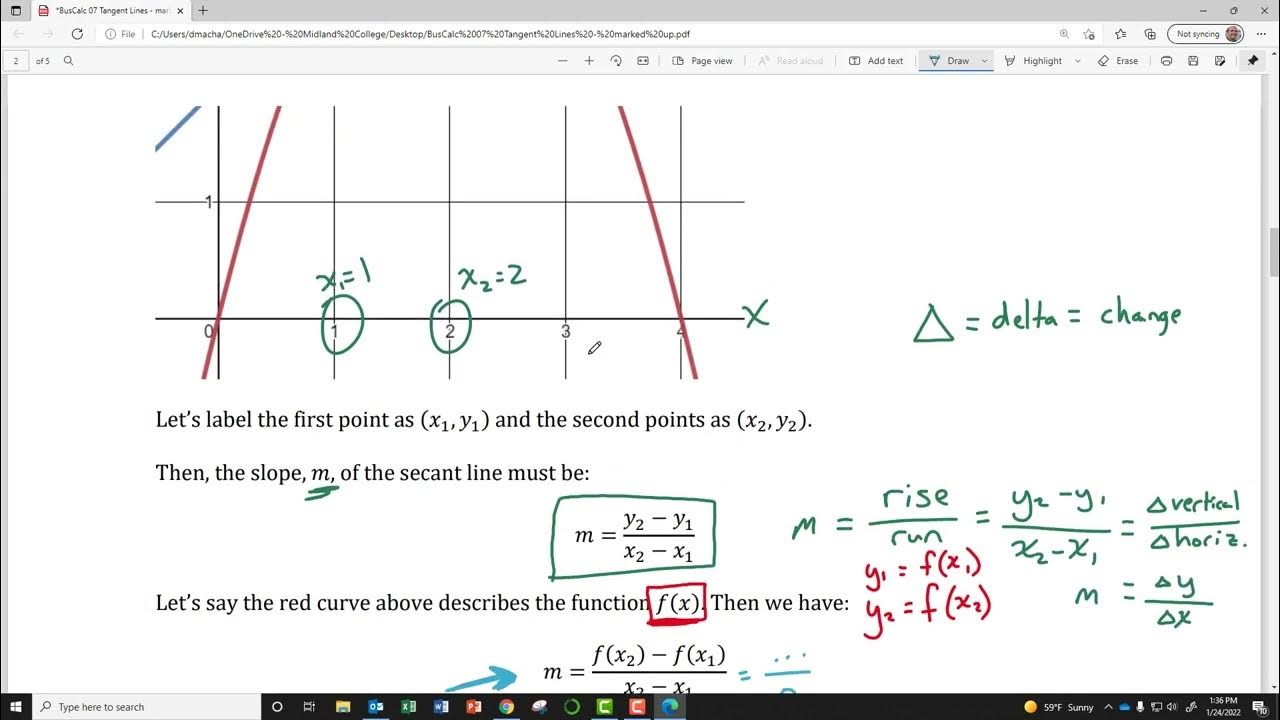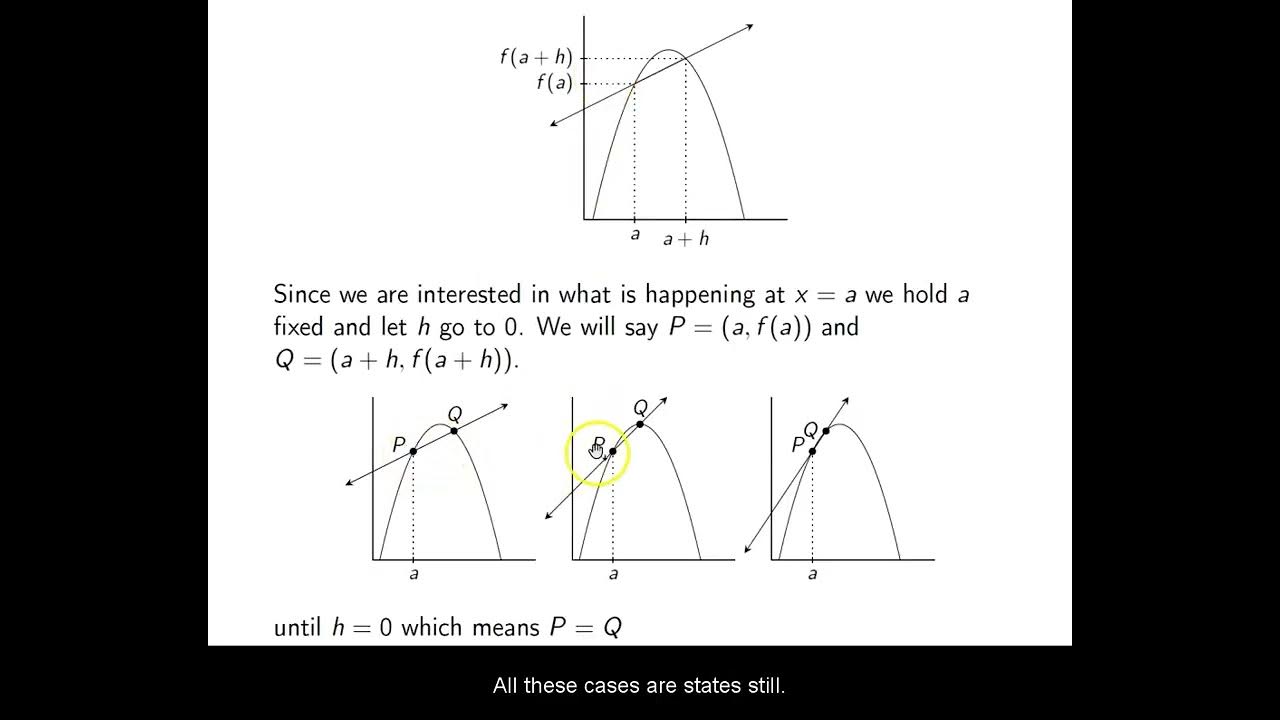Calculus 1: Limits & Derivatives (4 of 27) The Relationship Between the Slope and the Limit (2)
TLDRThis online lecture explores the relationship between slope and limits, focusing on the concept of tangent lines and secant lines in the context of a function on the XY plane. It demonstrates how the slope of a secant line approximates the slope of a tangent line and the function at a specific point by bringing point Q closer to point P. The lecture culminates in the mathematical expression of this process using limits, illustrating how the limit as ΔX approaches zero defines the slope of the tangent line, which is also the derivative of the function at point P. This fundamental concept is key to understanding derivatives in calculus.
Takeaways
- 📚 The lecture discusses the relationship between slope, limit, and derivatives in calculus.
- 📈 The slope of a tangent line is defined as the instantaneous rate of change at a specific point on a function.
- 📍 A tangent line touches the graph of a function at exactly one point, Point P.
- 📉 A secant line passes through Point P and another point, Point Q, on the graph of the function.
- 🔍 The slope of the secant line approximates the slope of the tangent line but is not exact.
- ➗ The slope of the secant line is calculated by the ratio of the rise over the run between points P and Q.
- 📝 The rise is the difference in y-coordinates (f(X + ΔX) - f(X)), and the run is the change in x-coordinates (ΔX).
- 🔑 As Point Q is moved closer to Point P, the slope of the secant line more closely matches the slope of the tangent line.
- 🚀 The concept of a limit is introduced as the process of bringing Point Q infinitely close to Point P, making ΔX approach zero.
- 🌟 In the limit, as ΔX approaches zero, the slope of the secant line converges to the slope of the tangent line, which is the derivative of the function at Point P.
- 🔬 The limit is a fundamental concept in calculus that helps in understanding derivatives and their applications.
Q & A
What is the primary focus of the lecture?
-The lecture focuses on the relationship between the slope of a tangent line and the concept of a limit, and how to write a limit in the context of calculus.
What is the definition of a tangent line as described in the lecture?
-A tangent line is defined as a line that touches the graph of a function at a single point, Point P, and does not intersect the graph at any other point.
What is the purpose of drawing a secant line in this context?
-The secant line is drawn to approximate the slope of the tangent line. It passes through Point P and another point, Point Q, on the function, and as Point Q is moved closer to Point P, the slope of the secant line more closely approximates the slope of the tangent line.
How is the slope of the secant line defined in the lecture?
-The slope of the secant line is defined as the ratio of the rise (change in Y values between Point Q and Point P) to the run (change in X values, which is Delta X).
What does the 'rise' in the context of the secant line represent?
-The 'rise' represents the vertical distance or the change in the Y values between Point Q and Point P, which is calculated as f(X + Delta X) - f(X).
What is the mathematical expression for the slope of the secant line?
-The slope of the secant line is expressed as (f(X + Delta X) - f(X)) / Delta X, where Delta X is a small change in the X coordinate.
How does bringing Point Q closer to Point P affect the slope of the secant line?
-Bringing Point Q closer to Point P makes the slope of the secant line more closely resemble the slope of the tangent line, thus providing a better approximation of the function's slope at Point P.
What is the significance of the limit in the context of finding the slope of the tangent line?
-The limit is used to find the exact slope of the tangent line by making Delta X approach zero, which means Point Q is brought extremely close to Point P, making the secant line's slope equal to the tangent line's slope.
How is the limit mathematically represented in the lecture?
-The limit is represented as the expression (f(X + Delta X) - f(X)) / Delta X as Delta X approaches zero, denoted by the limit symbol and the arrow indicating Delta X approaching zero.
What is the connection between the concept of the limit and derivatives in calculus?
-The concept of the limit is fundamental to understanding derivatives. The derivative of a function at a point is found by taking the limit of the function's slope as the change in X approaches zero.
Why are limits important in various situations in calculus?
-Limits are important because they help in understanding the behavior of functions as inputs approach certain values, which is essential for finding derivatives, among other applications in calculus.
Outlines
📚 Understanding Slope, Limit, and Tangent Line
This paragraph introduces the concept of the relationship between the slope of a tangent line and the limit in calculus. It explains how a tangent line touches a function at a single point, P, while a secant line passes through point P and another point, Q. The slope of the secant line is shown to approximate the slope of the function at point P, and this approximation improves as point Q is moved closer to point P. The mathematical expression for the slope of the secant line is derived using the rise over run concept, with rise being the difference in y-values (f(X + ΔX) - f(X)) and run being the change in x-values (ΔX). The paragraph concludes by illustrating how, in the limit as ΔX approaches zero, the slope of the secant line converges to the slope of the tangent line, which is the derivative of the function at point P.
🔍 The Role of Limits in Derivatives
The second paragraph delves deeper into the concept of limits and their significance in calculus, particularly in relation to derivatives. It emphasizes the process of approximating the slope of the tangent line by moving point Q closer to point P, which refines the approximation of the slope of the secant line. The paragraph clarifies that in the limit, as ΔX approaches zero, the ratio of rise over run converges to the slope of the tangent line, thereby defining the derivative of the function at point P. This concept is highlighted as fundamental in calculus, with the understanding of limits being crucial for grasping the idea of derivatives. The paragraph also hints at the broader applications of limits in various mathematical contexts, promising further exploration in upcoming videos.
Mindmap
Keywords
💡Slope
💡Limit
💡Tangent Line
💡Secant Line
💡Function
💡Point P
💡Point Q
💡Rise
💡Run
💡Delta X (Δx)
💡Derivative
Highlights
The lecture discusses the relationship between slope, limit, and derivatives in calculus.
Introduction to the concept of a tangent line touching the graph of a function at a single point.
Secant line is defined as a line that passes through two points on the function's graph, including point P.
The slope of the secant line approximates the slope at point P but is not exact.
The slope of the tangent line equals the slope of the function at the point of tangency.
To calculate the slope at point P, one can use the slope of the secant line as an approximation.
Moving point Q closer to point P refines the approximation of the secant line's slope to the function's slope at P.
The slope of the secant line is defined as the ratio of the rise over the run between points P and Q.
Rise is the difference in Y values between points Q and P, and run is the change in X values.
The change in Y values is represented by the function evaluated at X plus Delta X minus the function evaluated at X.
As Delta X approaches zero, the slope of the secant line approaches the slope of the tangent line.
The limit concept is used to describe the process of bringing points P and Q extremely close together.
The mathematical notation for the limit as Delta X approaches zero is introduced.
The limit of the rise over run as Delta X approaches zero equals the slope of the tangent line.
The slope of the tangent line is equal to the derivative of the function at point P.
The concept of the limit is fundamental to understanding derivatives in calculus.
The lecture will cover various applications of limits in future videos.
Transcripts
5.0 / 5 (0 votes)
Thanks for rating:





